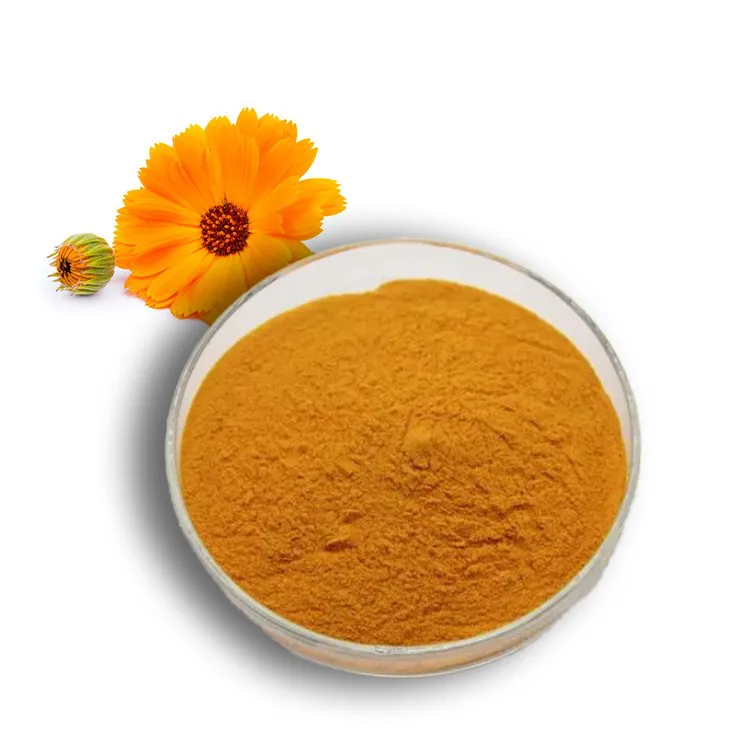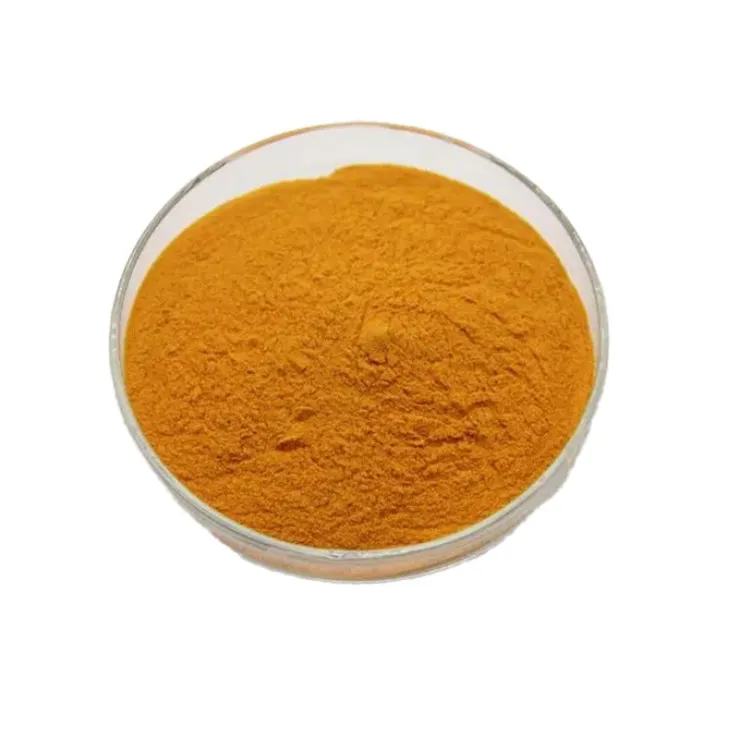- 0086-571-85302990
- sales@greenskybio.com
Calendula Extract: Uses, Advantages and Manufacturing Processes
2024-11-12

I. Introduction
Calendula Extract has emerged as a highly valuable substance in various industries. Derived from the Calendula plant, this extract has a rich history of use in traditional medicine and is now finding its way into modern applications as well. The Calendula plant, also known as pot marigold, is recognized for its bright yellow - orange flowers which are the source of the extract. This article will delve into the uses, advantages, and manufacturing processes of Calendula Extract.

II. Uses of Calendula Extract
1. In the Food Industry
Calendula extract serves as a natural colorant in the food industry. It imparts a beautiful yellow - orange hue to food products. This natural coloring alternative is becoming increasingly popular as consumers are more inclined towards products with natural ingredients. It can be used in a variety of food items such as baked goods, dairy products, and confectionery. For example, in some artisanal cheeses, a small amount of Calendula extract may be added to give a unique color and a touch of natural flavor. Additionally, in the production of certain candies or desserts, it can replace synthetic colorants, providing a more natural and visually appealing product.
2. In Dietary Supplements
The potential health - promoting properties of Calendula extract have led to its use in dietary supplements. It is believed to have antioxidant, anti - inflammatory, and antimicrobial properties. Antioxidants help in protecting the body's cells from damage caused by free radicals. The anti - inflammatory properties may be beneficial for individuals suffering from various inflammatory conditions. In dietary supplements, Calendula extract can be combined with other vitamins, minerals, and herbal extracts to create formulations that support overall health. For instance, it may be included in supplements designed to boost the immune system or improve digestive health.
3. In the Medical Field
Calendula extract has been the subject of numerous studies for its role in wound healing. It has the ability to accelerate the healing process by promoting cell regeneration. In topical applications, it can be used to treat minor cuts, burns, and abrasions. It helps in reducing inflammation at the wound site, preventing infection, and promoting the growth of new tissue. Some hospitals and healthcare facilities are now incorporating Calendula - based wound care products into their treatment regimens. Moreover, research is ongoing to explore its potential in treating more complex wound conditions such as chronic ulcers.
4. In Cosmetics
Calendula extract is also widely used in the cosmetics industry. Its anti - inflammatory and antioxidant properties make it suitable for use in skincare products. It can be found in creams, lotions, and serums designed for various skin types. For sensitive skin, Calendula - based products can help soothe irritation and redness. In anti - aging products, it may contribute to reducing the signs of aging by protecting the skin from oxidative stress. Additionally, its pleasant, natural fragrance makes it an appealing ingredient in perfumes and body sprays.

III. Advantages of Calendula Extract
1. Compatibility with Other Ingredients
One of the major advantages of Calendula extract is its excellent compatibility with other ingredients. It can be effortlessly combined with other botanicals or active ingredients in formulations. For example, in a skincare product, it can be blended with aloe vera, Lavender Extract, or vitamin E without any adverse reactions. This allows formulators to create complex and effective products by combining the benefits of multiple ingredients. In dietary supplements, it can be paired with other herbs like echinacea or ginseng to enhance the overall efficacy of the supplement.
2. Sustainability
Calendula is a relatively easy - to - grow plant, which makes Calendula extract a sustainable option. It can be cultivated in a variety of climates and soil conditions. Farmers can grow Calendula with minimal use of pesticides and fertilizers, reducing the environmental impact. Moreover, the plant has a relatively short growth cycle, allowing for multiple harvests in a year. This ensures a consistent supply of raw material for the extraction of Calendula extract, making it an environmentally friendly choice for industries relying on natural ingredients.
3. Pleasant Natural Fragrance
The Calendula extract has a pleasant, natural fragrance that is highly appealing in many products. In cosmetics, this natural scent can enhance the user experience without the need for artificial fragrances. In food products, it can add a subtle and pleasant aroma. For example, in some herbal teas that contain Calendula extract, the natural fragrance of the extract contributes to the overall sensory experience of the tea. In perfumes and body sprays, it can be used as a base note or blended with other natural fragrances to create unique and appealing scents.

IV. Manufacturing Processes of Calendula Extract
1. Sourcing of Calendula Flowers
The first step in the manufacturing process of Calendula extract is the careful sourcing of Calendula flowers. These flowers should be of high quality, preferably grown in an environment free from contaminants such as heavy metals and pesticides. Organic farming methods are often preferred to ensure the purity of the raw material. The flowers are typically harvested at the peak of their bloom when they contain the highest concentration of active components. Growers may also take measures to ensure that the flowers are not damaged during harvesting, as this can affect the quality of the extract.
2. Extraction Methods
There are several methods for extracting Calendula extract from the flowers. One common method is Soxhlet extraction. This method is known for its more comprehensive extraction of active components. In Soxhlet extraction, the Calendula flowers are placed in a Soxhlet apparatus, and a suitable solvent, such as ethanol or hexane, is used to extract the active compounds. The solvent is continuously recycled through the apparatus, allowing for a more efficient extraction process. Other extraction methods include maceration, where the flowers are soaked in a solvent for a period of time, and steam distillation, which is mainly used for extracting the essential oils from the Calendula flowers.
3. Refining and Quality Testing
After the extraction process, the Calendula extract needs to be refined to remove any impurities. This may involve processes such as filtration and evaporation to obtain a pure extract. Once refined, the extract undergoes quality testing. Stringent quality checks are carried out to ensure that the Calendula extract is free from contaminants such as heavy metals, pesticides, and microbial contaminants. These tests may include spectroscopic analysis to determine the chemical composition of the extract, as well as microbiological testing to check for the presence of bacteria, fungi, or other microorganisms. Only high - quality Calendula extract that meets the required standards is used for various applications.

V. Conclusion
In conclusion, Calendula extract is a versatile and valuable substance with a wide range of uses in the food, dietary supplement, medical, and cosmetics industries. Its advantages, such as compatibility with other ingredients, sustainability, and pleasant natural fragrance, make it an attractive option for formulators. The manufacturing process, which involves careful sourcing, extraction, refining, and quality testing, ensures that the final product is of high quality and suitable for its various applications. As research on Calendula extract continues, it is likely that new uses and benefits will be discovered, further expanding its role in various industries.
FAQ:
What are the main uses of Calendula extract in the food industry?
Calendula extract is mainly used as a natural colorant in the food industry. It imparts a beautiful yellow - orange hue to food products.
Why is Calendula extract considered in dietary supplements?
Calendula extract is considered for use in dietary supplements because of its potential health - promoting properties.
How does Calendula extract contribute to wound healing?
Calendula extract can accelerate the wound - healing process by promoting cell regeneration.
What makes Calendula extract compatible with other ingredients?
The chemical nature of Calendula extract allows it to be easily combined with other botanicals or active ingredients in formulations, making it highly compatible.
What is the significance of carefully sourcing Calendula flowers in the manufacturing process?
Carefully sourcing Calendula flowers is crucial as it ensures the quality of the extract. High - quality flowers are more likely to yield a pure and effective extract free from contaminants.
Related literature
- The Therapeutic Potential of Calendula officinalis Extracts"
- "Calendula in Cosmetics: Properties and Applications"
- "Manufacturing and Quality Control of Botanical Extracts: The Case of Calendula"
- ▶ Hesperidin
- ▶ citrus bioflavonoids
- ▶ plant extract
- ▶ lycopene
- ▶ Diosmin
- ▶ Grape seed extract
- ▶ Sea buckthorn Juice Powder
- ▶ Beetroot powder
- ▶ Hops Extract
- ▶ Artichoke Extract
- ▶ Reishi mushroom extract
- ▶ Astaxanthin
- ▶ Green Tea Extract
- ▶ Curcumin Extract
- ▶ Horse Chestnut Extract
- ▶ Other Problems
- ▶ Boswellia Serrata Extract
- ▶ Resveratrol Extract
- ▶ Marigold Extract
- ▶ Grape Leaf Extract
- ▶ blog3
- ▶ blog4
- ▶ blog5
-
Organic Tongkat Ali extract powder factory.
2024-11-12
-
How to make powder with ashwagandha extract.
2024-11-12
-
Rosehip extract manufacturers from China.
2024-11-12
-
The best cat's claw extract in nature.
2024-11-12
-
Chinese Dandelion Leaf Extract Suppliers.
2024-11-12
-
Chasteberry Extract
2024-11-12
-
Acerola Juice Powder
2024-11-12
-
Cocoa Extract
2024-11-12
-
Milk Thistle Extract
2024-11-12
-
Passionflower Extract
2024-11-12
-
Cassia Seed Extract
2024-11-12
-
Quercetin
2024-11-12
-
Curcuma Longa Extract
2024-11-12
-
Baicalin
2024-11-12
-
Sophora Flavescens Root Extract
2024-11-12





















